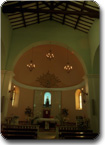
|
lThe parish church of Cessapalombo, defined in records as
“ecclesia castri”, that is, the church inside the castle, likely coeval with the fortress erected in 1266.
The church is mentioned in devises from 1494.
The church is mentioned as “Pievania” only in 1694, in substitution of the church of S. Maria dell’Impollata,
so-called because it stood in an area rich in natural springs (Colle di S. Maria, west of Cessapalombo); the
latter was Pievebefore the Castle was erected and enjoyed great prominence in the area up until its abandonment.
The church of S. Andrea underwent work on its façade at the end of the 1700s for damage caused by an earthquake,
and more recent restoration in the 1950s, losing its original architectural elements in the process.
A bell dated 1823 and polychrome wooden group of a figures from the 1400s representing the "Madonna dell’Impollata and Child",
possibly by an artist from Marches were transferred from the church of S. Maria dell’Impollata to S. Andrea.
|